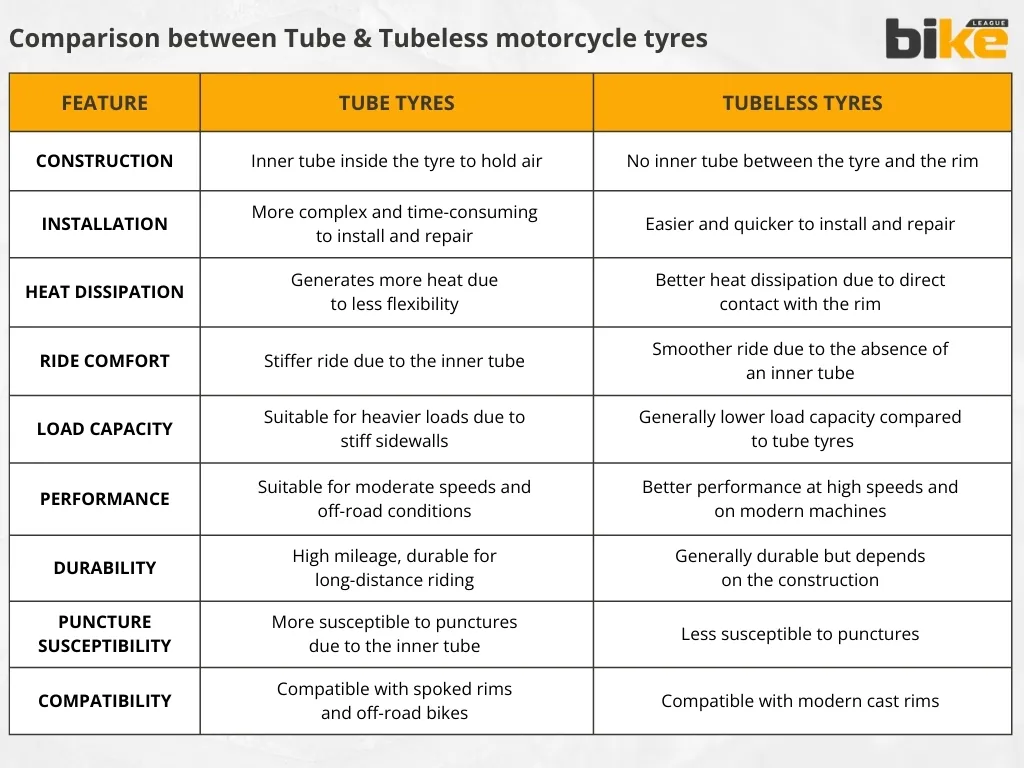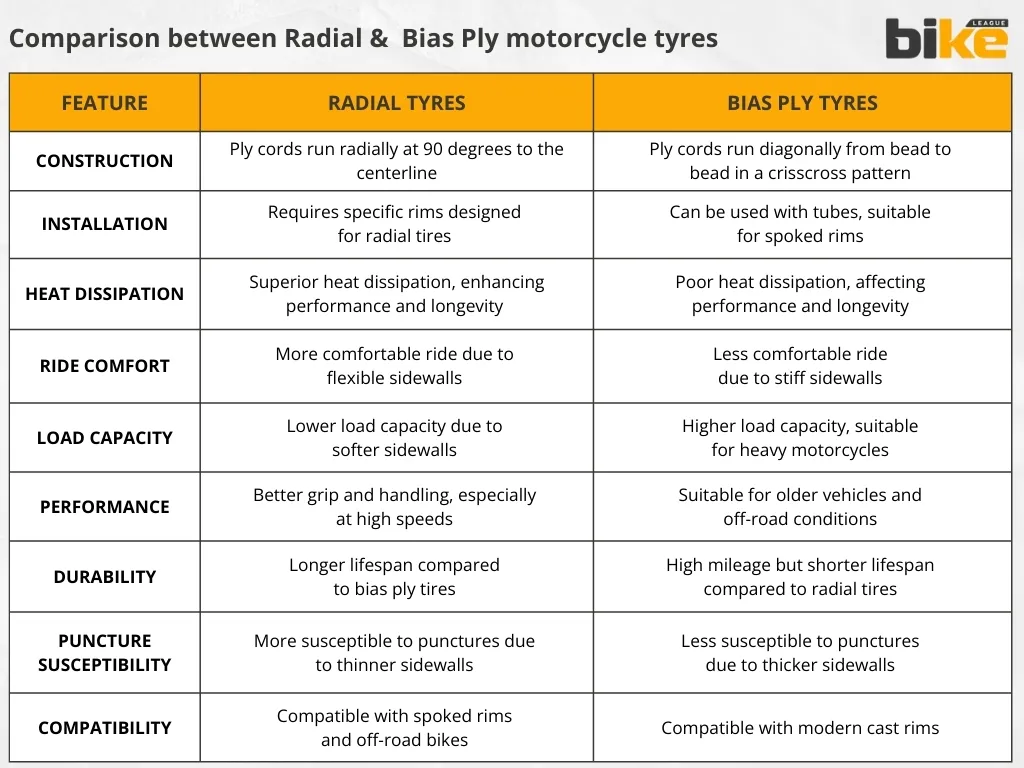
Long story short: Tyres are to a motorcycle what shoes are to our legs. Tyres are crucial, as they are the only part that touches the tarmac while riding. Here we discuss types of motorcycle tyres such as tubeless and radial, and their pros and cons.
Two-wheeler tyres are a significant component that brings huge safety aspects to the bike. They are the only element that comes into contact with the road. With proper tyres, motorcycle braking efficiency and grip improve. This minimises safety threats to the rider. Most bike riders are now conscious of this change, but only a certain percentage are fully aware.
Several people in India hesitate to change worn motorcycle tyres due to cost. However, this should be avoided, especially in India, where uneven roads and unexpected circumstances are common. Please always prioritise safety over money. In this article, we discuss tyre types based on material, usage conditions, technical aspects, and common tyre doubts.
Key Takeaways
- Tubeless Tyres offer the peace of mind of reduced sudden deflation and the ability to run at lower air pressure for better balance and vehicle stability.
- Tube-type tyres are a more traditional option and are more accessible for repair and replacement. They are more straightforward in design but more vulnerable to sudden air loss in punctures.
- Street motorcycle tyres are designed primarily for durability and reliability on paved roads.
- Dual-sport or adventure (ADV) tyres are built for riders who frequently switch between on-road and off-road terrains.
- Touring tyres are heavy-duty tyres with deep tread patterns designed to effectively dispel water. They are made from more complex rubber compounds to ensure excellent durability and are suited for long-distance highway touring.
- Off-road tyres feature knobby, deep treads for maximum grip on loose dirt, mud, sand, or gravel. These tyres are less stable on paved surfaces but excel in off-road conditions.
Types of two-wheeler tyres based on the material construction
1. Tubeless Tyres
These motorcycle tyres are rigid, durable, and constructed from strong rubber compounds. They reduce the risk of sudden deflation and can operate at lower air pressure, thereby improving balance and stability.
Pros of Tubeless tyres
- Improved air impermeability and resistance to heat and weather.
- Easier to repair and maintain.
- Better fuel efficiency due to lighter weight.
Cons of Tubeless tyres
- Higher initial cost compared to tube-type tyres.
2. Tube-Type Tyres
These motorcycle tyres are a traditional option, as they are easier to repair and replace due to their straightforward design, but are more prone to air loss when punctured.
Pros of Tube-type tyres
- Simplicity in design and easier to repair.
- Generally cheaper than tubeless tyres.
Cons of Tube-type tyres
- Vulnerable to sudden air loss in case of punctures.
- Heavier and less fuel-efficient compared to tubeless tyres.
Compare the features of tube and tubeless two-wheeler tyres in the chart below.
3. Bias Ply two-wheeler Tyres
This type of motorcycle tyre, also called diagonal tyres, has a carcass made of ply cords running diagonally to the tread’s centre line. These cords run bead to bead in alternating layers, creating a crisscross pattern.
Advantages of Bias Ply Tyres
- Load Capacity: Bias ply tyres have very stiff sidewalls, making them suitable for heavier motorcycles or bikes carrying heavier loads. This rigidity allows them to carry greater weight and perform well under heavy loads.
- High Mileage: These tyres are known for their high mileage capabilities, making them a durable option for long-distance riding.
- Compatibility with Tubes: Bias ply tyres can be used with tubes, which is necessary for spoked rims and off-road riding.
Disadvantages of Bias Ply Tyres
- Heat Dissipation: One of the main downsides is their poor heat dissipation, which can affect performance and longevity.
- Ride Comfort: While beneficial for load capacity, the stiff sidewalls can result in a less comfortable ride than radial tyres.
4. Radial Tyres
This motorcycle tyre has a different construction. The ply cords radiate at 90-degree angles to the tread’s centre line. The cords run directly from bead to bead. This allows for a more flexible sidewall than other types.
Advantages of Radial Tyres
- Heat Dissipation: Radial tyres dissipate heat better due to their construction, which includes steel belts that help manage heat more effectively.
- Ride Comfort: The thinner and more flexible sidewalls act as a ‘spring,’ absorbing bumps and providing a smoother ride.
- Performance: Radial tyres offer better grip, especially when leaning into corners, and are suitable for high-speed, sporty purposes. They are essential for more powerful motorcycles with a rigid chassis.
Disadvantages of Radial Tyres
- Puncture Susceptibility: The thinner sidewalls are more susceptible to punctures while providing comfort.
- Load Capacity: Radial tyres generally have a lower load capacity compared to bias ply tyres due to their softer sidewalls.
Differences Between Bias Ply and Radial Two-Wheeler Tyres
- Construction: Bias ply motorcycle tyres have diagonal ply cords, while radial tyres have ply cords that run radially.
- Sidewall Rigidity: Bias ply tyres have stiffer sidewalls, making them better for heavy loads, whereas radial tyres have softer sidewalls, providing a smoother ride.
- Heat Management: Radial tyres dissipate heat better, which enhances performance and longevity, especially at high speeds.
- Application: Bias ply tyres are suitable for moderate speeds and heavier loads, often used in touring and off-road motorcycles. Radial tyres are preferred for high-performance, sporty motorcycles due to their superior grip and handling.
Check out the comparison between bias ply and radial two-wheeler tyres in the chart given below.
Types of two-wheeler tyres based on usage conditions
1. Street Tyres
Street motorcycle tyres are designed to provide two key advantages: durability for long-term use and reliability on paved roads. Smooth tread patterns with diagonal grooves enhance water dispersion and reduce the risk of hydroplaning.
Pros of Street Tyres
- Long durability and reliability
- Better grip on wet surfaces due to more treads
Cons of Street Tyres
- Limited performance on off-road terrains
Motorcycle Street Tyres Examples
| Brand | Tyre Model / Series | Compatible Motorcycles | Tyre Sizes (Front / Rear) | Official Link |
|---|---|---|---|---|
| MRF | Nylogrip, Masseter-X | Bajaj Pulsar, TVS Apache, Honda Shine, Yamaha FZ | 100/80-17 (Front), 130/70-17 (Rear) | Know More |
| Apollo | Actizip, Alpha H1 | KTM Duke series, Bajaj Pulsar, TVS Apache | 110/70-17 (Front), 150/60-17 (Rear) | Know More |
| Michelin | Pilot Street, Road 5 | Bajaj Dominar, Kawasaki Ninja, KTM Duke | 110/70 ZR17 (Front), 150/60 ZR17 (Rear) | Know More |
| CEAT | Milaze, Zoom XL | Royal Enfield Himalayan, Bajaj Pulsar, TVS Apache | 100/90-19 (Front), 110/70-17 (Rear) | Know More |
| Pirelli | Diablo Rosso, Scorcher 11 | TVS Apache, Yamaha FZ, Suzuki Gixxer | 100/80-17 (Front), 140/75 R15 (Rear) | Know More |
| TVS Eurogrip | ATT 455 | TVS Apache, Honda CB Shine | 100/90-19 (Front), 120/80-18 (Rear) | Know More |
2. Dual Sport or ADV Tyres
Dual-sport or adventure (ADV) tyres give riders versatility and adaptability, offering reliable traction on both on-road and off-road surfaces due to their unique tread pattern.
Pros of Dual Sport or ADV Tyres
- Versatile, suitable for both on-road and off-road use
- Good traction on slick and muddy terrains
Cons of Dual Sport or ADV Tyres
- May not offer the best performance on either surface compared to specialised tyres
Dual Sport or ADV Tyres Examples
| Brand | Tyre Model / Series | Compatible Motorcycles | Tyre Sizes (Front / Rear) | Official Link |
|---|---|---|---|---|
| Pirelli | SCORPION™ Rally STR | Royal Enfield Himalayan, Triumph Tiger 900/1200, KTM Adventure | 90/90 R21 (Front), 150/70 R18 (Rear) | Know More |
| Eurogrip | Trailhound SCR | Royal Enfield Interceptor, Continental GT 650, KTM 390 Adventure | 80/20 road-offroad tread | Know More |
| Mitas | ENDURO TRAIL+ | KTM 390 Adventure R, KTM 125 Enduro R | Aggressive tread for offroad grip | Know More |
| Michelin | Anakee Wild | Royal Enfield Himalayan, BMW G310 GS, KTM Adventure | 90/90-21 (Front), 150/70-17 (Rear) | Know More |
| Metzeler | Karoo 4 | BMW GS series, Triumph Tiger, KTM Adventure | 110/80 R19 (Front), 150/70 R17 (Rear) | Know More |
| Bridgestone | Battlax Adventure Trail | Kawasaki Versys, Suzuki V-Strom, BMW GS | Multiple sizes typical for ADV | Know More |
Touring tyres provide the advantage of durability for long-distance rides and feature deep tread patterns that enhance water dispersion. Their more complex rubber compounds ensure they last longer on highways.
Pros of Touring Tyres
- Excellent water dispersion, reducing the risk of hydroplaning
- Long mileage and good traction in wet conditions
Cons of Touring Tyres
- Heavier and may not provide the same level of grip as sport tyres
Touring Tyres Examples
| Brand | Tyre Model / Series | Compatible Motorcycles | Tyre Sizes (Front / Rear) | Official Link |
|---|---|---|---|---|
| Reise tourR | ReiseMoto | Royal Enfield Classic, Royal Enfield Thunderbird | Common sizes: 90/90-19, 120/80-18 | Know More |
| Michelin Road 5 | Michelin | Bajaj Dominar, KTM Duke series, Kawasaki Ninja | 110/70 ZR17 (F), 150/60 ZR17 (R) | Know More |
| Pirelli Sport Demon | Pirelli | BMW G310 GS, KTM 390 Adventure, Triumph Tiger | 110/70-17, 140/70-17, 150/60-17 | Know More |
| Bridgestone Battlax BT-46 | Bridgestone | Kawasaki Versys, Suzuki V-Strom, BMW GS series | 110/80-19, 150/70-17 | Know More |
| Apollo Actigrip | Apollo | Bajaj Pulsar, TVS Apache, KTM Duke | 100/80-17 (F),130/70-17 (R) | Know More |
Sport or performance tyres offer the major advantage of maximum grip and superior performance in dry conditions. They are ideal for motorcycles needing excellent handling and high-speed stability.
Pros of Sport / Performance Tyres
- Superior grip and handling at high speeds
- Lightweight and superb handling
Cons of Sport / Performance Tyres
- Faster wear and tear due to softer rubber compounds
- Not ideal for wet or off-road conditions
Sport / Performance Tyres Examples
| Brand | Tyre Model / Series | Compatible Motorcycles | Tyre Sizes (Front / Rear) | Official Link |
|---|---|---|---|---|
| Apollo | Pilot Street, Road 5 | KTM 200 Duke, KTM 250 Duke, TVS Apache RR 310, KTM RC200, KTM RC390, KTM Duke 390, Mahindra Mojo | 110/70 ZR17 (Front), 150/60 ZR17 (Rear) | Know More |
| Michelin | Pilot Street, Road 5 | Bajaj Dominar, Benelli TNT series, BMW K1600 GTL, KTM 200 Duke | 110/70 ZR17 (Front), 150/60 ZR17 (Rear) | Know More |
| Metzeler | Sportec M5, M7 RR | Bajaj Dominar, Benelli TNT series, BMW K1600 GTL, KTM 200 Duke | 110/70 ZR17 (Front), 150/60 ZR17 (Rear) | Know More |
| Pirelli | Diablo Rosso II, Sport Demon | Widely suitable for sport and racing motorcycles | Common sizes: 110/70-17, 140/70-17, 150/60-17 | Know More |
| MRF | Revz, Masseter-X, Zapper Q | Wide compatibility with Indian sport and racing bikes | Example sizes: 100/80-17, 130/70-17, 140/60-17 | Know More |
| TVS Eurogrip | Protorq Sport HR | Mainly for Indian sportbikes like TVS Apache | 110/70-17 (Front), 150/60-17 (Rear) | Know More |
Sport touring tyres are a hybrid between sport and touring tyres. They provide performance and grip comparable to sports tyres, while offering enhanced durability and ruggedness for longer rides.
Pros of Sport Touring Tyres
- Balanced performance and durability
- Suitable for long rides with good traction and mileage
Cons of Sport Touring Tyres
- May not excel in either sport or touring performance compared to specialised tyres
6. Off-Road Tyres
Off-road tyres feature knobby, deep treads for maximum grip on loose dirt, mud, sand, or gravel. These tyres are less stable on paved surfaces but excel in off-road conditions.
Pros of Off-Road Tyres
- Excellent traction on unpaved terrains
- Designed to handle tough and rough conditions
Cons of Off-Road Tyres
- Unstable and noisy on paved roads
Off-Road Tyres Examples
| Tyre Model | Brand | Compatible Motorcycle Models | Tyre Sizes (Front / Rear) | Official Link |
|---|---|---|---|---|
| Scorpion Rally STR | Pirelli | Hero Xpulse, KTM Enduro, VT 1300CX, KTM Travel, Triumph Tiger, Honda Africa Twin | 110/70-17 (F), 150/70-18 (R) | Know More |
| Anakee Adventure | Michelin | Hero Xpulse, Triumph Tiger, Benelli TNT, Royal Enfield Himalayan | 90/90-21 (F), 150/60 R17 (R) | Know More |
| Ralco Moto Cross | Ralco | Hero Xpulse 200 4V, Yezdi Adventure, Royal Enfield Himalayan | 90/90-21 (F), 120/80-18 (R) | Know More |
| CEAT Gripp XL | CEAT | Royal Enfield Himalayan, Yezdi Adventure, Honda Africa Twin | 90/90-21 (F), 120/90-17 (R) | Know More |
| MRF Mogrip Meteor-M | MRF | Royal Enfield Himalayan, Yezdi Adventure, Honda Africa Twin | 90/90-21 (F), 120/90-17 (R) | Know More |
| Karoo 3 | Metzeler | Benelli Leoncino, BMW R1200 GS, Suzuki V-Strom, Triumph Tiger, Adventure bikes | 110/80 R19 (F), 150/70-17 (R) | Know More |
7. Racing Tyres / Slicks
This type of motorcycle tyre, also known as slicks, provides the ultimate grip and is used exclusively for professional motorcycle racing. These tyres have a smooth surface with no tread, maximising the contact patch with the road for superior traction.
Pros of Racing Tyres / Slicks
- Maximum grip and performance on race tracks
- Can handle high speeds, rapid acceleration, and quick turns
Cons of Racing Tyres / Slicks
- Not suitable for everyday use or wet conditions
- High wear rate and limited lifespan
Racing Tyres / Slicks Examples
| Brand | Tyre Model / Series | Compatible Motorcycles | Tyre Sizes (Front / Rear) | Official Link |
|---|---|---|---|---|
| Apollo | Alpha H1 | KTM 200 Duke, KTM 250 Duke, TVS Apache RR 310, KTM RC200, KTM RC390, KTM Duke 390, Mahindra Mojo | 110/70 ZR17 (Front), 150/60 ZR17 (Rear) | Know More |
| Michelin | Pilot Street, Road 5 | Bajaj Dominar, Benelli TNT series, BMW K1600 GTL, KTM 200 Duke | 110/70 ZR17 (Front), 150/60 ZR17 (Rear) | Know More |
| Metzeler | Sportec M5, M7 RR | Bajaj Dominar, Benelli TNT series, BMW K1600 GTL, KTM 200 Duke | 110/70 ZR17 (Front), 150/60 ZR17 (Rear) | Know More |
| Pirelli | Diablo Rosso II, Sport Demon | Widely suitable for sport and racing motorcycles | 110/70-17, 140/70-17, 150/60-17 | Know More |
| MRF | Revz, Masseter-X, Zapper Q | Wide compatibility with Indian sport and racing bikes | 100/80-17, 130/70-17, 140/60-17 | Know More |
| TVS Eurogrip | Protorq Sport HR | Mainly for Indian sportbikes like TVS Apache | 110/70-17 (Front), 150/60-17 (Rear) | Know More |
FAQ related to different types of two-wheeler tyres
1. What are the main types of two-wheeler tyres available in India?
Two-wheeler tyres can be broadly classified into tubeless and tube-type tyres. Tubeless tyres are preferred because they better maintain air pressure and provide a smoother ride. In contrast, tube-type tyres are more traditional and often used in older models.
2. What are the two different two-wheeler tyre constructions available?
Tyres can be constructed as radial or bias (cross-ply). Radial tyres offer better performance at high speeds. They are cooler during long rides, while bias tyres are more durable and suitable for heavy loads.
3. What are the different rubber compounds used in tyres?
Tyres are made from rubber compounds, including soft, medium, hard, and dual. Soft compound tyres provide better grip but wear out faster, while hard compound tyres last longer but offer less traction. Dual compound tyres combine the benefits of both.
4. Which type of motorcycle tyres is the best one?
It all depends on the user’s preference. We recommend tubeless tyres instead of tubeless tyres, as they offer more safety. All other tyre options depend on road type and riding environment.
5. Which is better, the bias-ply tyre or the radial tyre?
It purely depends on ride conditions and user preferences.
6. Is tyre size an essential factor when choosing two-wheeler tyres?
Yes, skinny tyres offer more mileage and longevity and are less expensive. At the same time, wider tyres provide more traction and grip, but they also reduce mileage and decrease longevity. Always stick to the tyre size mentioned in the owner’s manual; otherwise, it will affect the whole performance and ergonomics of the motorcycle.
7. What is the tread pattern in two-wheeler tyres?
Tread refers to the rubber surface on the tyre that makes contact with the road. A tread pattern is the tyre design comprising channels and grooves to dissipate water away from the contact patch. Without a tread pattern, a tyre cannot be used in wet conditions and is prone to excessive slipping and loss of control. Tyre tread patterns differ among tyre types used for various road conditions.
Other related articles from Bikeleague India
- Adventure bikes vs Touring bikes which one is the best
- Bike Tyre Polish in India
- Two wheeler tyre code – How to read & understand – video
- Top 5 most expensive bikes in India
- What is Nitrogen & air filling in bikes? – Doubts & FAQ
Conclusion
In this article, we have discussed the types of two-wheeler tyres based on various criteria, along with related questions and answers. If you have any other questions or queries, email us at bikeleague2017@gmail.com. You can also share your doubts or opinions in the comments section below. We are always eager to help and assist you. Additionally, there are several social media platforms associated with Bikeleague India that may raise your suspicions.



